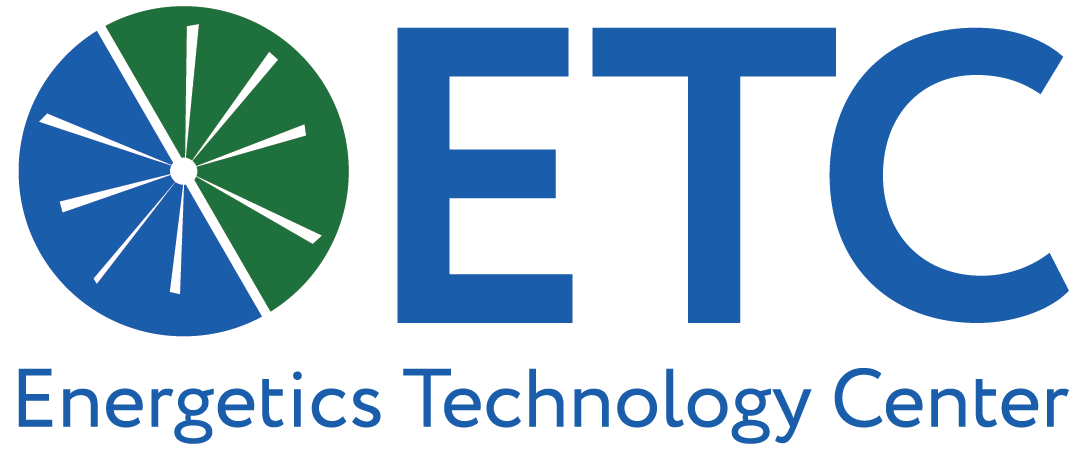Cyber SyncED: Expanding Cybersecurity Education for Every Student
In a world where digital systems power everything from healthcare to the arts, cybersecurity literacy has become a universal skill. The Energetics Technology Center (ETC) is leading the charge with Cyber SyncED, an innovative STEM education initiative that makes cybersecurity accessible to all learners—not just those pursuing technical fields.
Whether a student plans to be a lawyer, journalist, designer, or entrepreneur, understanding the fundamentals of cybersecurity gives them a vital edge in today’s interconnected world.
About the Cyber SyncED Program
ETC worked in collaboration with the University of Maryland Global Campus (UMGC) and the Army Research Laboratory (ARL) to create Cyber SyncED, which advances cybersecurity and AI education for both students and educators. The program consists of two key components:
-
CyberTEACH – Professional development for educators, equipping teachers on how to integrate cybersecurity and AI concepts into non-STEM curricula.
-
CyberLEARN – Hands-on cybersecurity training for middle and high school students, building a talent pipeline for national security and defense innovation.
Through immersive, real-world experiences, Cyber SyncED bridges the gap between education and the cybersecurity workforce—preparing both teachers and students to thrive in a digital future.
Making Cybersecurity Accessible and Engaging
Cyber SyncED is designed to ensure every learner, regardless of background, can grasp and apply cybersecurity fundamentals. Its four guiding pillars include:
-
Inclusive Curriculum for Non-STEM Students: Concepts are presented through creative, relatable projects that make cybersecurity approachable for all learners.
-
Project-Based, Hands-On Learning: Students participate in virtual escape rooms, simulated cyberattacks, and interactive exercises that spark critical thinking.
-
Expert-Led Instruction: Lessons are guided by cybersecurity professionals who bring real-world insights and relevance to every session.
-
Career Pathway Exploration: Students connect cyber skills to diverse career fields—from healthcare and law to finance and the arts—building confidence and curiosity.
CyberTEACH: Empowering Educators Through AI and Cyber Literacy
The CyberTEACH initiative focuses on advancing educator training in cybersecurity, artificial intelligence (AI), and generative AI (GAI). By empowering teachers, ETC amplifies cyber awareness and creativity across entire school communities.
Cohort Progress
In June 2025, ETC hosted two concurrent cohorts of CyberTEACH training:
-
Cohort 7: Included 28 educators from five non-public schools in Washington, D.C., and Maryland—primarily Catholic single-sex institutions such as The Academy of the Holy Cross, Elizabeth Seton High School, Georgetown Visitation, and DeMatha High School.
-
Cohort 8: Included 22 educators from California’s Inglewood Unified School District, representing a public-school model focused on scalability, equity, and accessibility.
Participants completed pre- and post-program assessments evaluating growth in cybersecurity knowledge, AI applications, and classroom integration strategies.
Key Findings:
-
Cohort 7 excelled in creative and ethical curriculum integrations, using approaches like theatre-based cyber lessons and faith-driven digital ethics.
-
Cohort 8 achieved consistent, scalable results through district-level implementation and inclusivity measures, including English Language Learner (ELL) support.
A third cohort (Sept. 27–Oct. 25, 2025) continued this momentum, training 20 educators from 16 schools across Maryland, D.C., and Virginia—further expanding CyberTEACH’s reach and reinforcing ETC’s leadership in cyber education.
CyberLEARN: Preparing Students for the Cyber Workforce
The CyberLEARN program engages middle and high school students through experiential learning that builds confidence, technical skills, and interest in cybersecurity careers tied to national security.
High School Program
ETC enhanced the 2025 high school CyberLEARN curriculum with new features developed in collaboration with UMGC and feedback from the Inglewood Bootcamp. Additions included Cyber Range simulations, expanded lab time, and a Capture the Flag competition during the summer session in Adelphi, MD (July 28–August 1, 2025). Students also toured the NSA Cryptologic Museum, linking lessons to real-world applications.
Program Results:
-
71% of students improved understanding of digital system protection.
-
82% gained hands-on experience with cybersecurity tools.
-
83% learned about Department of Defense (DoD) STEM fields and career opportunities.
Student engagement continues beyond the classroom through the Cyber Club at Perry Hall High School, where participants have:
-
Competed in the National Cyber Cup and CyberPatriot competitions.
-
Participated in events like the UMBC Hackathon and GoTechnica at the University of Maryland, College Park.
ETC is also developing the JROTC CyberBridge initiative, extending CyberLEARN to Junior Reserve Officers’ Training Corps (JROTC) programs. This effort targets non-STEM cadets and supports workforce development to address the national shortage of over 500,000 cybersecurity professionals, including 27,050 vacancies in Maryland alone.
Advancing Cyber Education, Building a Secure Future
Through Cyber SyncED, ETC continues to expand cybersecurity education beyond traditional boundaries—connecting educators, students, and communities to the skills needed for a safe and resilient digital future.
By bridging education, innovation, and national security, ETC is not only addressing the cybersecurity talent gap but also inspiring the next generation of leaders to think critically, ethically, and creatively about the digital world.


 Sheri Tiller joins ETC as a STEM Educator, bringing a lifelong passion for teaching and learning. Her extensive background includes more than a decade of experience teaching in diverse environments. Sheri has developed and delivered innovative curricula tailored to a wide range of student learning styles and has long embraced technology to enhance education, using web-based learning tools before they became standard practice. She continues to integrate creativity and artistry into her approach to STEM instruction.
Sheri Tiller joins ETC as a STEM Educator, bringing a lifelong passion for teaching and learning. Her extensive background includes more than a decade of experience teaching in diverse environments. Sheri has developed and delivered innovative curricula tailored to a wide range of student learning styles and has long embraced technology to enhance education, using web-based learning tools before they became standard practice. She continues to integrate creativity and artistry into her approach to STEM instruction.
 Returning for his second year with ETC, Bill Weber continues to support RoboMasterminds as a STEM Educator. With more than 20 years of experience as an engineering teacher for Baltimore County Public Schools, Bill has cultivated a broad skill set in robotics, technical theatre, and professional development. He has coached the award-winning VEX Robotics teams since 2008, led technical theatre programs, and supported county-wide training for Career and Technical Education (CTE) teachers. At ETC, Bill develops curricula and leads hands-on STEM workshops designed to ignite a passion for engineering among the next generation of innovators.
Returning for his second year with ETC, Bill Weber continues to support RoboMasterminds as a STEM Educator. With more than 20 years of experience as an engineering teacher for Baltimore County Public Schools, Bill has cultivated a broad skill set in robotics, technical theatre, and professional development. He has coached the award-winning VEX Robotics teams since 2008, led technical theatre programs, and supported county-wide training for Career and Technical Education (CTE) teachers. At ETC, Bill develops curricula and leads hands-on STEM workshops designed to ignite a passion for engineering among the next generation of innovators. Bobby Appleton, Ph.D., joins ETC as a machine learning engineer supporting NSWC Indian Head Division. Bobby has a strong background in all areas of computational materials science with an expertise in developing predictive models for energetic materials using state-of-the-art ML/AI methods. While a member of the Purdue Energetics Research Center, Bobby collaborated with various DoD and academic researchers through the Advancing Army Modernization Program – Energetic Materials (AAMP-EM) and the Energetic Materials Basic Research (EMBR) cooperative agreements. He received his B.A. in Physics from Ripon College, M.S. in Physics from California State University – Los Angeles, and Ph.D. in Materials Engineering from Purdue University. Bobby supports the NSWC Indian Head Chemical Scale-Up group for optimizing synthesis processes of energetic materials.
Bobby Appleton, Ph.D., joins ETC as a machine learning engineer supporting NSWC Indian Head Division. Bobby has a strong background in all areas of computational materials science with an expertise in developing predictive models for energetic materials using state-of-the-art ML/AI methods. While a member of the Purdue Energetics Research Center, Bobby collaborated with various DoD and academic researchers through the Advancing Army Modernization Program – Energetic Materials (AAMP-EM) and the Energetic Materials Basic Research (EMBR) cooperative agreements. He received his B.A. in Physics from Ripon College, M.S. in Physics from California State University – Los Angeles, and Ph.D. in Materials Engineering from Purdue University. Bobby supports the NSWC Indian Head Chemical Scale-Up group for optimizing synthesis processes of energetic materials.  Howard Cho, a robotics engineer with advanced experience in autonomous navigation, recently joined ETC with a focus on robotic systems development. His work includes leading the design of a 360° perception and navigation system for Boston Dynamics’ Spot robot, utilizing real-time SLAM mapping and GPS-based hybrid autonomy. Howard’s integration of adaptive path planning, vision-language models, and multimodal robotic control showcases his cutting-edge contributions to the field. His innovations support ETC’s robotics and AI research in dynamic and GPS-denied environments.
Howard Cho, a robotics engineer with advanced experience in autonomous navigation, recently joined ETC with a focus on robotic systems development. His work includes leading the design of a 360° perception and navigation system for Boston Dynamics’ Spot robot, utilizing real-time SLAM mapping and GPS-based hybrid autonomy. Howard’s integration of adaptive path planning, vision-language models, and multimodal robotic control showcases his cutting-edge contributions to the field. His innovations support ETC’s robotics and AI research in dynamic and GPS-denied environments.  Caleb Harper, Ph.D., joins ETC as a chemical/mechanical engineer supporting NSWC Indian Head Division as an energetics formulator. With extensive research experience from the Purdue Energetics Research Center, Caleb has developed, tested, and evaluated experimental rocket propellants and explosive formulations. He holds a B.S. in Chemical Engineering from Brigham Young University and a Ph.D. in Mechanical Engineering from Purdue University. Caleb’s work supports critical Navy R&D in next-generation energetic materials. Outside the lab, Caleb is an avid linguist, musician, and licensed pilot.
Caleb Harper, Ph.D., joins ETC as a chemical/mechanical engineer supporting NSWC Indian Head Division as an energetics formulator. With extensive research experience from the Purdue Energetics Research Center, Caleb has developed, tested, and evaluated experimental rocket propellants and explosive formulations. He holds a B.S. in Chemical Engineering from Brigham Young University and a Ph.D. in Mechanical Engineering from Purdue University. Caleb’s work supports critical Navy R&D in next-generation energetic materials. Outside the lab, Caleb is an avid linguist, musician, and licensed pilot.  Sarah Kirby joins ETC as a STEM Educator, supporting the organization’s growing education and workforce development programs at ARL and NSWC Indian Head. A former science teacher in Southern Maryland, Sarah holds a B.S. in Public Health Science and a Science, Technology, and Society Scholars Citation from the University of Maryland. She is currently leading hands-on STEM summer camps and developing a cybersecurity-focused after-school program designed to introduce middle school students to digital safety, literacy, and tech careers. Her passion for education and outreach is helping shape the next generation of innovators.
Sarah Kirby joins ETC as a STEM Educator, supporting the organization’s growing education and workforce development programs at ARL and NSWC Indian Head. A former science teacher in Southern Maryland, Sarah holds a B.S. in Public Health Science and a Science, Technology, and Society Scholars Citation from the University of Maryland. She is currently leading hands-on STEM summer camps and developing a cybersecurity-focused after-school program designed to introduce middle school students to digital safety, literacy, and tech careers. Her passion for education and outreach is helping shape the next generation of innovators.  Brian Matheny serves as ETC’s Chief Financial Officer. In this role, Brian is responsible for overseeing financial strategy, corporate reporting, and fiscal management to support long-term organizational growth. Brian has more than 18 years of experience in financial planning and analysis, budgeting, and strategic leadership within the government contracting industry. He previously served as FP&A Manager at Noblis MSD (formerly McKean Defense Group) where he oversaw all key financial metrics and reporting for their Defense Mission Areas. Brian holds a B.B.A. in Finance and an MBA in Innovation both from James Madison University.
Brian Matheny serves as ETC’s Chief Financial Officer. In this role, Brian is responsible for overseeing financial strategy, corporate reporting, and fiscal management to support long-term organizational growth. Brian has more than 18 years of experience in financial planning and analysis, budgeting, and strategic leadership within the government contracting industry. He previously served as FP&A Manager at Noblis MSD (formerly McKean Defense Group) where he oversaw all key financial metrics and reporting for their Defense Mission Areas. Brian holds a B.B.A. in Finance and an MBA in Innovation both from James Madison University.  Joan Michel joins ETC as its VP of Strategic Initiatives. Her role is to help drive growth, internal excellence, and client outcomes. She brings 25 years of experience helping federal, state, and local governments develop, plan, and implement strategic initiatives, including creating private-public partnerships, managing strategy and planning efforts, developing education and workforce programs, and providing communications and outreach expertise. She has served the defense and homeland security sector in multiple roles — as an Army civilian, a contractor, and a small business. Joan holds a master’s degree in Organization Development from Pennsylvania State University and a bachelor’s from University of Maryland Baltimore County.
Joan Michel joins ETC as its VP of Strategic Initiatives. Her role is to help drive growth, internal excellence, and client outcomes. She brings 25 years of experience helping federal, state, and local governments develop, plan, and implement strategic initiatives, including creating private-public partnerships, managing strategy and planning efforts, developing education and workforce programs, and providing communications and outreach expertise. She has served the defense and homeland security sector in multiple roles — as an Army civilian, a contractor, and a small business. Joan holds a master’s degree in Organization Development from Pennsylvania State University and a bachelor’s from University of Maryland Baltimore County.  Bridget O’Gorman joins ETC remotely from Minnesota as a Technical Engagement Lead on the BEST START program, supporting the START Center at University of St. Thomas in Saint Paul and the seven local companies awarded grants through BEST START. She has wide-ranging hands-on experience including power electronics and high-energy, pulsed power weapons systems, giving her a unique perspective on technological collaboration. Bridget holds a B.S. of Electrical Engineering from University of Minnesota and will complete her M.S. of Electrical Engineering at UST in December.
Bridget O’Gorman joins ETC remotely from Minnesota as a Technical Engagement Lead on the BEST START program, supporting the START Center at University of St. Thomas in Saint Paul and the seven local companies awarded grants through BEST START. She has wide-ranging hands-on experience including power electronics and high-energy, pulsed power weapons systems, giving her a unique perspective on technological collaboration. Bridget holds a B.S. of Electrical Engineering from University of Minnesota and will complete her M.S. of Electrical Engineering at UST in December.  Donovan Ramos comes to ETC as a Technology Specialist, with plans to advance into a system administrator role. A sophomore at Harford Community College studying computer engineering, Donovan previously interned with ETC and AEOP and has supported ARL’s ROS research network. His technical responsibilities include managing networking infrastructure at ETC’s Aberdeen office, responding to internal tech inquiries, and contributing to robotics R&D. A former FIRST Tech Challenge competitor, Donovan also brings hands-on experience with 3D modeling, electronics, and autonomous vehicles.
Donovan Ramos comes to ETC as a Technology Specialist, with plans to advance into a system administrator role. A sophomore at Harford Community College studying computer engineering, Donovan previously interned with ETC and AEOP and has supported ARL’s ROS research network. His technical responsibilities include managing networking infrastructure at ETC’s Aberdeen office, responding to internal tech inquiries, and contributing to robotics R&D. A former FIRST Tech Challenge competitor, Donovan also brings hands-on experience with 3D modeling, electronics, and autonomous vehicles.  Beth Watson provides graphic design support for ETC. Current projects include updating the ETC brand and accompanying collateral; website design and maintenance on RoboMasterminds.org, BestStart.io, Cybersynced.org, and ETCMD.com; client and internal support with graphic design of a multitude of projects including social media, exhibits, flyers, newsletters, and more. She brings over 30 years of experience in visual communication, project management, creative services, and art direction; and has supported a wide range of teams and clients across the country. Her background is rooted in a deep love of fine arts and tactile functional crafts. She is passionate about creating design solutions that are both effective and accessible.
Beth Watson provides graphic design support for ETC. Current projects include updating the ETC brand and accompanying collateral; website design and maintenance on RoboMasterminds.org, BestStart.io, Cybersynced.org, and ETCMD.com; client and internal support with graphic design of a multitude of projects including social media, exhibits, flyers, newsletters, and more. She brings over 30 years of experience in visual communication, project management, creative services, and art direction; and has supported a wide range of teams and clients across the country. Her background is rooted in a deep love of fine arts and tactile functional crafts. She is passionate about creating design solutions that are both effective and accessible. 



